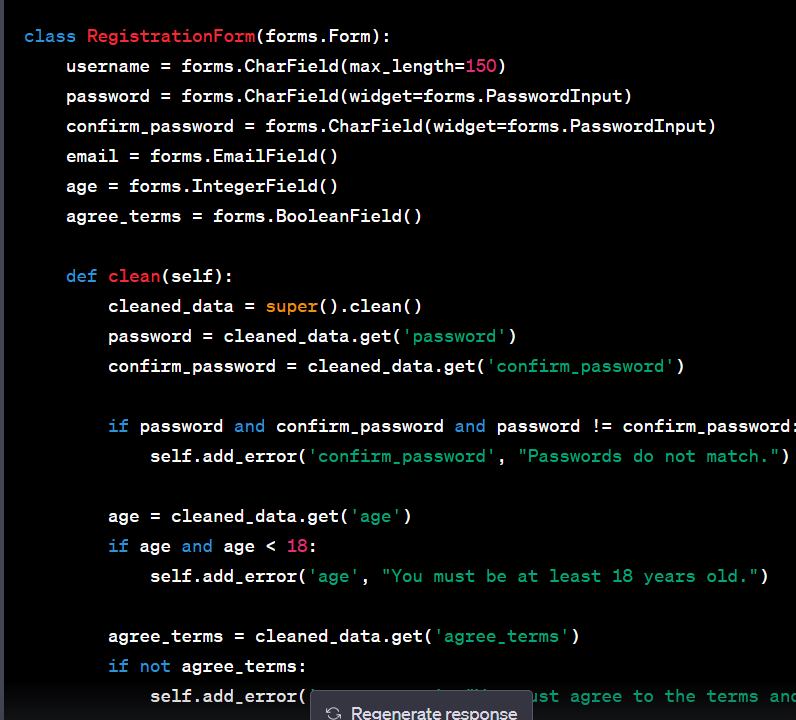Apply custom Validation during custom authentication
Define the User model.
Open myapp/models.py and define a custom User model, if needed. Django provides a built-in User model that can be used for authentication. If you want to extend the User model, you can create a custom model by subclassing AbstractBaseUser or AbstractUser.
Create a form for login and registration in your forms.py file:
from django import forms
class LoginForm(forms.Form):
username = forms.CharField(max_length=150)
password = forms.CharField(widget=forms.PasswordInput)
class RegistrationForm(forms.Form):
username = forms.CharField(max_length=150)
password = forms.CharField(widget=forms.PasswordInput)
confirm_password = forms.CharField(widget=forms.PasswordInput)
email = forms.EmailField()
age = forms.IntegerField()
agree_terms = forms.BooleanField()
def clean(self):
cleaned_data = super().clean()
password = cleaned_data.get('password')
confirm_password = cleaned_data.get('confirm_password')
if password and confirm_password and password != confirm_password:
self.add_error('confirm_password', "Passwords do not match.")
age = cleaned_data.get('age')
if age and age < 18:
self.add_error('age', "You must be at least 18 years old.")
agree_terms = cleaned_data.get('agree_terms')
if not agree_terms:
self.add_error('agree_terms', "You must agree to the terms and conditions.")
Create view functions for login and registration in your views.py file:
from django.shortcuts import render, redirect
from .forms import LoginForm, RegistrationForm
def login_view(request):
if request.method == 'POST':
form = LoginForm(request.POST)
if form.is_valid():
# Perform login logic
return redirect('home')
else:
form = LoginForm()
return render(request, 'login.html', {'form': form})
def registration_view(request):
if request.method == 'POST':
form = RegistrationForm(request.POST)
if form.is_valid():
# Perform registration logic
return redirect('login')
else:
form = RegistrationForm()
return render(request, 'registration.html', {'form': form})
Create corresponding HTML templates login.html and registration.html in your templates directory. Here's an example of login.html:
<h2>Login</h2>
<form method="post">
{% csrf_token %}
{{ form.as_p }}
<button type="submit">Login</button>
</form>
And an example of registration.html:
<h2>Registration</h2>
<form method="post">
{% csrf_token %}
{{ form.as_p }}
<button type="submit">Register</button>
</form>
Define the URL patterns in your urls.py file:
from django.urls import path
from . import views
urlpatterns = [
path('login/', views.login_view, name='login'),
path('registration/', views.registration_view, name='registration'),
]
With the above code, the RegistrationForm handles six different types of validations:
Password matching validation: The form checks if the password and confirm password fields have the same value.
Email validation: The form checks if the email field contains a valid email address.
Age validation: The form checks if the age field is provided and the user is at least 18 years old.
Agreement validation: The form checks if the agree_terms field is checked.
Required field validation: All fields are required by default, so the form will display errors if any required field is not provided.
CSRF protection: The form automatically includes a CSRF token to protect against CSRF attacks.


Top comments (0)